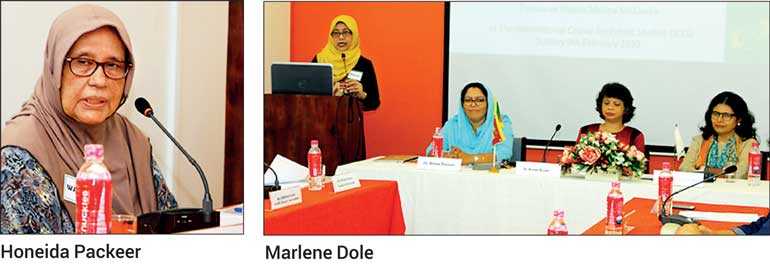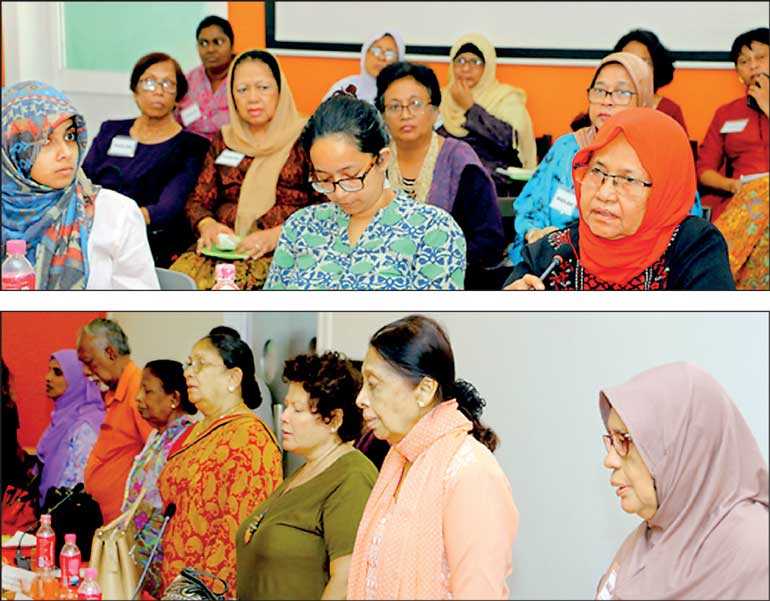Thursday Nov 20, 2025
Thursday Nov 20, 2025
Friday, 13 March 2020 00:02 - - {{hitsCtrl.values.hits}}

On Sunday 9 February, the Women’s Association of Sri Lanka Malays (WASLAM) organised an interactive discussion on, ‘Building Bridges and Breaking Barriers’. The main focus of the event was to initiate conversation among different women’s groups on how best as Sri Lankans living in a multi-ethnic population, women could contribute towards building bridges, breaking down barriers and mending fences to maintain peace and harmony in the country.
The Women’s Association of Sri Lanka Malays (WASLAM) was inaugurated in April 2010. The main focus of the Association is to be the unified voice and platform for the Sri Lankan Malay women. WASLAM’s work revolves around the empowerment of women and uplifting and developing women’s skills at grassroots.
WASLAM President Marlene Dole welcomed the gathering and explained the mission and vision of WASLAM. Dole also added that, WASLAM’s work also revolves around the revitalisation and preservation of Malay language and culture. It is important that as caretakers of the nation, we, as women, lead important discussions pertaining to topical issues in the country, such as this.
Adding to this, WASLAM Founder and Past President Honeida Packeer said that it has become apparent that there is an urgent need now more than ever to have closer interaction within the ethnic groups of our country to be able to nurture peace, harmony and unity. So as caregivers and the mainstay of a family, we women are best suited to meet this need.
Spearheading the discussion were Dr. Minna Thaheer – a Senior Researcher at the Centre for Poverty Analysis heading the ‘Social Cohesion and Reconciliation’ thematic, and Dr. Farzana Haniffa – a Senior Lecturer in Sociology at the University of Colombo and a Smuts visiting fellow in Commonwealth studies at the Centre for South Asian Studies at the University of Cambridge (2018/19). The discussion was moderated by Dr. Romola Rasool, a Senior Lecturer at the Department of English Language Teaching in the Faculty of Humanities, University of Kelaniya, whose research interests include Sri Lanka Malays and minority languages of Sri Lanka.
A brief history of ‘minoritisation’ in Sri Lanka
Dr. Thaheer discussed the trend of the so-called Arabisation seen today, its cultural transition and practices. She spoke on the stand of the Muslims vis-a-vis building a plural democracy in a multi-ethnic country such as Sri Lanka. Her address also brought to light suggestions on what Muslims can do to be seen as active participants in building a cohesive democratic society in the country.
Speaking on the idea of a ‘nation-state’, Dr. Farzana Haniffa explained that the modern era, as we know it now, began with a group of people who identified in a common language. With the emergence of the Sinhala Only Act of 1956, for the first time, questions were raised on the justification of minority groups that did not identify with the common language, organisation of majority-minority relations and the mobilisation of political systems that began to reflect ethnic backgrounds.
Simultaneous to this sense of ‘Sinhala nationalism’ emerged a ‘Tamil nationalism’ that led to the ethnic conflict as we know it, and in the midst of it all, Dr. Haniffa noted that “the Muslims were almost forgotten. Of the Muslims, as a result of its sectoral divisions scattered across the island, and even to-date, only 30% of the total Muslim population live in the Eastern Province.”
Dr. Haniffa also explained in her address the idea of a ‘riot’ that she described as, “Before the 1980s, the idea of a ‘riot’ was almost always where a group of people would ‘riot’ against another group of people. In almost every instance, ‘riots’ were organised by the minor political actors, fuelled by the economic actors in the area.” She went on to say that prior to the 80s, the first recorded post-colonial ‘riot’ to have taken place in 1956 was after the official language registration, and in 1976, the politically-motivated riots in Puttalam between the Sinhala and Muslim communities.
Speaking on post-war Sri Lanka, Dr. Haniffa pointed out that until 2009, the ‘primary other targets’ of the Sinhala were the Tamils. However, after the end of the war, a new phase of the anti-Muslim movement began and a new ‘other’ is born.
“The polarisation between the communities began during the war. The transformation in the Muslim communities that we speak of didn’t happen in a vacuum. It happened in a particular context when they were marginalised and the ‘Arabisation’, as well as the influence from South India, were key contributors towards this transformation. This same transformation of certain Muslim communities gave them enormous confidence and strength and simultaneously gave way to a polarisation within the Muslim community itself, who were resisting this transformation and radicalisation of Muslim youth,” said Dr. Haniffa.

What does 52% of the Sri Lankan population mean?
Speaking on the majority female population and their capabilities was Daya Herath from the Community Education Centre, a not for profit organisation that works in issues pertaining to gender, ethnicity, social injustice, poverty and environment.
Herath said, since the 1970s they have been working in the districts of Monaragala and Trincomalee and there hasn’t been an issue among the ethnicities because the work they do is with the women and it is encouraging to see women coming together irrespective of their ethnic background. Herath reiterated that the focus here is to ensure that we first prioritise ourselves as women before we take on an ethnic labelling.
Adding to this, Sri Lanka Housewives Association President Nazeera Raban said that as one of the largest women’s organisations in Sri Lanka with membership in 17 branches around the island, the SL Housewives Association work brings women together from different parts of the island irrespective of ethnicity, religion or caste and this has made the organisation realise that as a team, we, the women are capable of doing anything to reach various goals.
Another representative from the Community Education Centre in Malabe (NGO), Malani Perera said that, despite there being 52% of women in the country, there is always a matter of representation. She also said that, the women of Sri Lanka can come from different socio-cultural backgrounds, different ethnic upbringing and even wear different attire; however, we have many commonalities and these can only be voiced out by a representative that we identify as our own.
Adding to the question of the representation of women, Dr. Haniffa also pointed out that the genuine lack of exposure and economic constraints to be among the reasons why women are often discouraged from seeking their place in areas of governance.
Hayati Rassool, an undergraduate, pointed out that in spite of her vast inexperience in comparison with the other highly qualified moderator and panellists present, she spoke as the only member of the Muslim/Malay youth present in the room. She argued that it was easy to theorise about building bridges in the abstract, but opinion formation about race, religion, gender and ethnicity begins in the home and is often stalled by families’ unwillingness to discuss such issues.
She pointed out how many Muslim friends of hers were unaware of issues directly affecting the rest of the Muslim youth in the country, such as the MMDA, stemming from the fact that their parents and grandparents simply did not bring up these problems or directly answer their questions. She therefore argued that more direct involvement in creating dialogue, from the point of view of the youth, would be an ideal way to move from theorising about building bridges to tackling issues such as ethnic conflict, radicalisation and the MMDA.

From awareness to implementation
One of the key takeaway factors at the discussion was the need for raising awareness. An invitee at the discussion from the Young Women’s Muslim Association said that it is important to educate the minds of women. Be it conducting awareness programs or training, it is important to teach women and empower them, if we are to move forwards. Adding to this, Malathi Wijesekera from Young Women’s Christian Association emphasised that, all people were created equally and it is imperative that we carry this message with us as citizens of the country.
The discussion ended with several open-ended questions. The event, held at the International Centre for Ethnic Studies, is only the beginning of more topical discussions in the months to come.